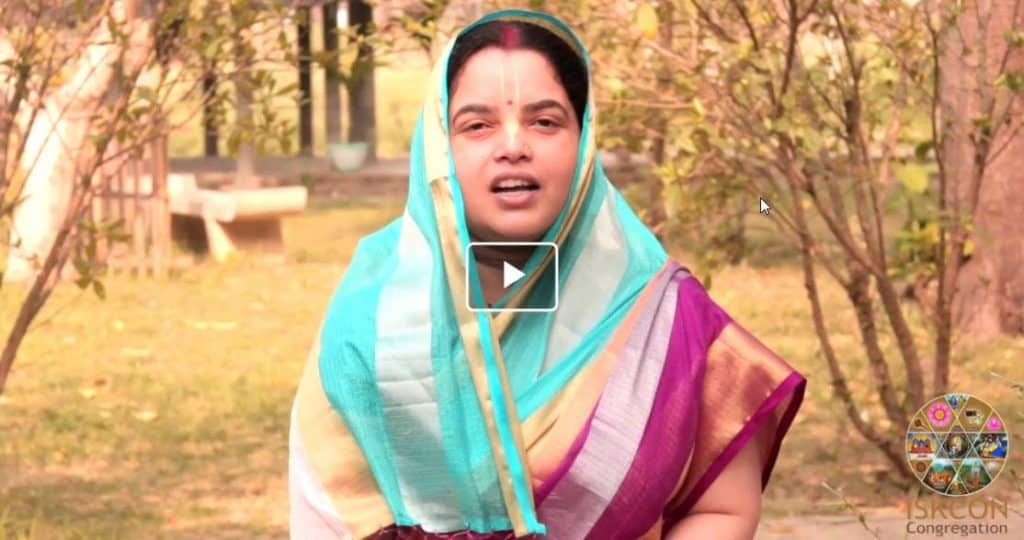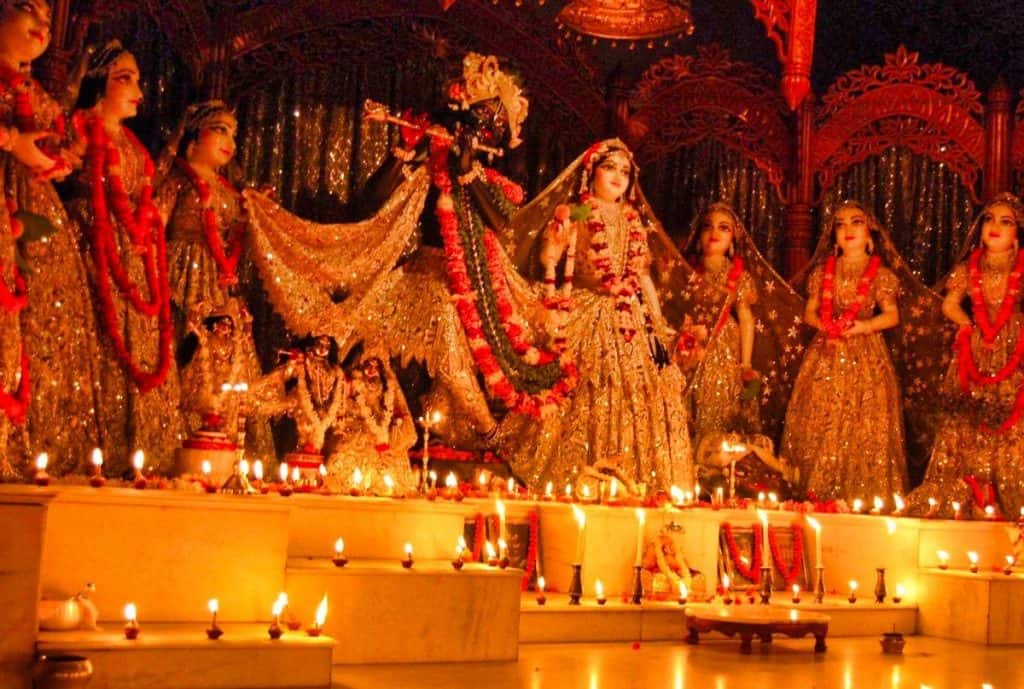
By Her Grace Srimati Dasi
According to Srila Rupa Gosvami, laughter in ecstatic love can be broken down into six divisions. These divisions, according to different degrees of smiling, are called in the Sanskrit language smita, hasita, vihasita, avahasita, apahasita and atihasita. These six classes of smiling can be further classified as major and minor. The major division includes smita, hasita and vihasita smiling, and the minor division includes avahasita, apahasita and atihasita smiling.
Srila Rupa Gosvami also tells us there’s a pattern to all this smiling. Smita (mild smiling) and Hasita (overt smiling) usually appear on the faces of Krsna’s superiors (sages, confidential advisors or older friends). Vihasita (soft laughter) and Avahasita (intense laughter) appear sometimes in Krsna’s messengers or servants. Apahasita (uncontrollable laughter) and Atihasita (extreme laughter) usually appear in children or old Vrajavasis associating with young children. But of course, the pattern may break at any time to accommodate the mood and pastime ⎯ and Krsna’s desire. Such is the delightful nature of Vrindavana!
1. Smita
When one is smiling but his teeth are not visible, one can distinctly mark a definite change in the eyes and in the cheeks. This is called smita smiling.
Once when Krsna was stealing yogurt, Jarati, the headmistress of the house, could detect His activities, and she was therefore coming very hurriedly to catch Him. At that time, Krsna became very much afraid of Jaraté and went to His elder brother, Baladeva. He said, “My dear brother, I have stolen yogurt! Just see — Jarati is coming hurriedly to catch Me!”
When Krsna was thus seeking the shelter of Baladeva because He was being chased by Jarati, all the great sages in the heavenly planets began to smile ⎯ and so did Baladeva! This smiling is called smita smiling.

2. Hasita
Smiling in which the teeth are slightly visible is called hasita smiling.
One day Abhimanyu, the so-called husband of Radharani, was returning home, and at that time he did not know that Krsna was there. But Krsna immediately changed His dress to look exactly like Abhimanyu and approached Abhimanyu’s mother, Jatila, addressing her thus: “My dear mother, I am your real son Abhimanyu, but just see — Krsna, dressed up like me, is coming before you!” Jatila, the mother of Abhimanyu, immediately believed that Krsna was her own son and thus became very angry at her real son who was coming home. She began to drive away her real son, who was crying, “Mother! Mother! What are you doing?”
Seeing this incident, all the girlfriends of Radharani who were present there began to smile, and a portion of their teeth was visible. This is an instance of hasita smiling.
Our search for an hasita smile on the face of one of Krsna’s beloveds was unsuccessful. However Krsna, captured on canvas in His later kaumara years, kindly gives us a glimpse of how enchanting such a smile can be……

3. Vihasita
When the teeth are distinctly visible in a smile, that is called vihasita.
One day when Krsna was engaged in stealing butter and yogurt in the house of Jatila, He assured His friends, “My dear friends, I know that this old lady is now sleeping very soundly, because she is breathing very deeply. Let us silently steal butter and yogurt without making any disturbance.”
But the old lady, Jatila, was not sleeping ⎯ and so she could not contain her smiling. She audibly laughed and her teeth immediately became distinctly visible. This is an instance of vihasita smiling.
Such smiles are often found on the faces of Krsna’s playful gopa friends. And such vihasita smiles are even found on the moonlike faces of His beloved gopis…..

4. Avahasita
In a state of smiling when the nose becomes puffed and the eyes squint, the smiling is called avahasita.
Once, early in the morning when Krsna returned home after performing His rasa dance, Mother Yasoda looked upon Krsna’s face and addressed Him thus: “My dear son, why do Your eyes look like they have been smeared with some oxides? Have You dressed Yourself with the blue garments of Baladeva today?”
When Mother Yaçoda was addressing Krsna in that way, a girlfriend who was nearby began to smile with a puffed nose and squinting eyes. This is an instance of avahasita smiling.
The gopi knew that Krsna had been enjoying the rasa dance and that Mother Yasoda could not detect her son’s activities or understand how He had become covered with the gopis makeup. Her smiling was in the avahasita feature.

5. Apahasita
When tears from the eyes are added to the smiling (and laughing) and the shoulders are shaking, the smile is called apahasita.
When child Krsna was dancing in response to the singing of the old maidservant Jarati, Narada was astonished.
The Supreme Personality of Godhead, who controls all the movements of great demigods like Brahma, was now dancing to the indications of an old maidservant. Seeing this fun, Narada also began to dance, and his shoulders trembled, and his eyes moved.
Due to his smiling, his teeth also became visible, and on account of the glaring effulgence from his teeth, the clouds in the skies turned silver.
6. Atihasita
When a smiling person claps his hands and leaps in the air, the smiling expression changes into atihasita, or overwhelming laughter.
An example of atihasita was manifested in the following incident.
Krsna once addressed Jarati thus: “My dear good woman, the skin of your face is now slackened, and so your face exactly resembles that of a monkey. As such, the King of the monkeys, Balimukha, has selected you as his worthy wife.”
While Krsna was teasing Jarati in this way, she replied that she was certainly aware of the fact that the King of the monkeys was trying to marry her, but she had already taken shelter of Krsna, the killer of many powerful demons, and therefore she had already decided to marry Krsna instead of the King of the monkeys.
Hearing this sarcastic reply by the talkative Jarati, all the cowherd girls present there began to laugh very loudly and clap their hands. Such laughter, accompanied by the clapping of hands, is called atihasita.
Concluding Words

It’s a fascinating science, isn’t it?! Just hearing about it is enough to lighten a troubled heart and put a smile on a tired face! And it’s not a rare or exclusive science. There are 82 hits for smiles and smiling in Krsna Book alone. That’s close to a smile a chapter – even though so many chapters deal with killing demons! Ecstatic loving laughter ⎯ with all it’s smiles! ⎯ is DEFINITELY a delightfully prominent and pervading aspect of Vrindavana culture and pastimes.
Beyond the material world dominated by the three modes of nature is the splendid divine ocean of bliss that is the bija syllable of the Kamagayatri mantra. In that ocean is a wonderfully beautiful island. In that island is the realm of Vrindavana, and in a secluded place of Vrindavana is an enchantingly beautiful forest garden. In that garden are Sri Sri Radhika-Krsnacandra, the two great treasures of intense transcendental bliss. Please worship Them with great devotion.
Srila Prabodhananda Sarasvati Thakura, Sri Vrindavana-mahimamrita (Çataka 3, Verse 11)
As an act of gratitude for our sponsors, we, the Congregational Development Ministry, offer a monthly offering on behalf of all our donors. Subscribe and get a monthly puja for Lord Nrisimhadev done on your family’s name!
To subscribe to the monthly offering to Lord Nrsimhadev in the name of your family, please visit our website
https://iskconcongregation.com/cdm-subscriptions/


